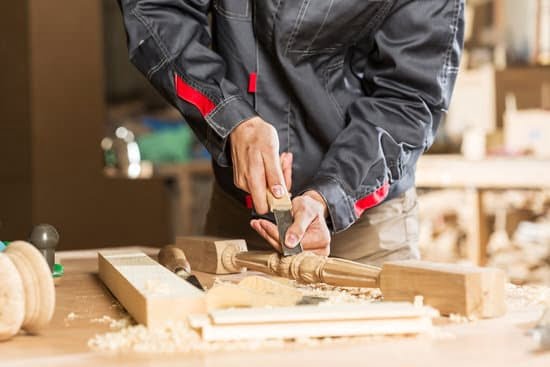A woodworking vise is an essential tool for any woodworking enthusiast or professional. Whether you’re a beginner just starting out or a seasoned craftsman, a woodworking vise plays a crucial role in holding your workpieces securely in place while you shape, cut, or join them. In this article, we will specifically focus on mounting a Craftsman woodworking vise and explore the various steps involved in setting it up for optimal functionality.
Craftsman is a renowned brand known for its high-quality tools and equipment, and their woodworking vises are no exception. Crafted with precision and durability in mind, Craftsman vises provide reliable clamping power to ensure that your workpiece remains steady throughout the entire woodworking process. From small projects to larger pieces of furniture, having a Craftsman woodworking vise mounted on your workbench can greatly enhance the efficiency and accuracy of your work.
In the following sections of this article, we will delve deeper into understanding different models and types of Craftsman vises available on the market. We will also discuss key features and specifications to consider when selecting the ideal vise for your needs. Additionally, we will provide step-by-step instructions on how to mount the vise securely onto your workbench, tips on proper alignment and tightening, as well as maintenance guidelines to keep your Craftsman woodworking vise in excellent condition.
So whether you’re looking to upgrade your current vise or seeking guidance on mounting a new Craftsman woodworking vise, this article aims to be your comprehensive resource. By following the outlined steps and recommendations provided here, you can enjoy the many benefits of having a properly mounted Craftsman woodworking vise that will undoubtedly elevate your future woodwork projects.
Understanding Craftsman Woodworking Vises
Craftsman offers a wide range of woodworking vises, each designed to cater to different needs and preferences. Understanding the various models and types of vises that Craftsman offers can help you make an informed decision when selecting a vise for your woodworking projects.
One popular option is the bench vise, which is typically mounted on the edge of a workbench. This type of vise provides stability and allows for secure clamping of workpieces. Another option is the portable vise, which can be easily attached to different surfaces, making it versatile for various woodworking tasks. The choice between these models depends on factors such as available workspace and the specific requirements of your projects.
When selecting a Craftsman woodworking vise, it’s important to consider key features and specifications that will enhance its functionality. Some important considerations include the jaw width and opening capacity, which determine the size of the workpieces that can be accommodated. Additionally, look for features like swivel bases or quick-release mechanisms that can improve efficiency in your woodworking tasks. By evaluating these factors, you can choose a Craftsman vise that best fits your needs.
Key Features to Consider
– Jaw width: Determines the maximum width of workpieces that can be held securely.
– Opening capacity: Specifies the maximum opening size between jaws.
– Swivel base: Enables rotation of the vise for optimal positioning during woodworking tasks.
– Quick-release mechanism: Allows for easy and fast adjustment of clamping pressure.
– Material construction: Consider durability and strength based on materials used in construction, such as cast iron or steel.
The Benefits of Choosing a Craftsman Vise
– Quality craftsmanship: With Craftsman’s reputation for producing high-quality tools, you can trust that their vises are built to withstand demanding woodworking projects.
– Versatility: Craftsmanship offers a range of models that cater to different woodworking tasks and workbench setups.
– Reliability: Craftsman vises are known for their stability and secure clamping, providing a trustworthy solution for all your woodworking needs.
– Longevity: Investing in a Craftsman vise means investing in a tool that is built to last, allowing you to enjoy its benefits for years to come.
By understanding the different models and features offered by Craftsman, you can make an informed decision when choosing a woodworking vise that meets your specific requirements. Whether you need a bench vise or a portable vise, Craftsman offers quality options for every woodworker.
Preparing for Installation
Once you have selected the ideal mounting location for your Craftsman woodworking vise, it’s time to gather the necessary tools and equipment to ensure a smooth installation process. Having the right tools on hand will not only make the installation easier but also guarantee that the vise is securely mounted for optimal functionality. Here is a comprehensive list of essential tools and equipment that you will need:
- Measuring Tape: This tool will be crucial for accurately measuring and marking the location where you plan to mount your vise on the workbench.
- Pencil or Marker: Use a pencil or marker to make clear marks on the workbench indicating where the holes for mounting should be drilled.
- Drill and Drill Bits: A power drill is necessary for drilling holes into the workbench to secure the vise. Make sure you have drill bits of suitable size for creating pilot holes before driving in screws.
- Screwdriver: Depending on the type of screws provided with your Craftsman woodworking vise, you may need either a flathead or Phillips screwdriver to fasten them securely.
- Clamps: Clamps can be useful during installation to hold parts in place while drilling pilot holes or fastening screws. They provide extra stability and prevent any movement that could affect alignment.
- Wrenches: You may require an adjustable wrench or an open-end wrench to tighten any nuts or bolts that come with your Craftsman woodworking vise.
- Safety Equipment: Always prioritize safety during any installation project. Wear protective goggles to shield your eyes from debris and use gloves when handling sharp objects or working with tools.
Once you have gathered all these tools and equipment, it’s important to ensure that everything is in good working condition before proceeding with the installation process. Check that your drill has sufficient battery life, and inspect all screws, nuts, and bolts to make sure they are not damaged or stripped. Taking these preparatory steps will help ensure a smooth and hassle-free installation of your Craftsman woodworking vise.
Gathering Everything You Need
Now that you have your list of tools and equipment, it’s time to gather everything you need before starting the installation process. By gathering all the necessary items in one place, you can avoid disruptions and save time during installation.
Create a designated workspace near your workbench where you can lay out all the tools and equipment in an organized manner. It is also helpful to have a sturdy table or flat surface nearby to place any components or parts that may be temporarily removed during the installation.
Take inventory of your tools and make sure they are all readily accessible. Check if you need to replenish any screws, drill bits, or other common items that may be running low. Additionally, gather any product manuals or guides provided with your Craftsman woodworking vise as they may contain specific instructions or diagrams for the installation process.
Having everything prepared before starting the installation process will minimize interruptions and create an efficient workflow. It is recommended to review the entire installation process outlined in this article once again before beginning, ensuring you fully understand each step and have all the necessary tools at hand. With proper preparation, mounting your Craftsman woodworking vise will be a smooth and enjoyable experience.
Practical Tips for a Smooth Installation
To ensure a smooth installation process for your Craftsman woodworking vise, here are some practical tips:
- Work in a well-lit area: Proper lighting is essential to accurately mark measurements and align the vise during installation. Ensure that your work area has sufficient lighting to avoid any mistakes or misalignments.
- Keep a vacuum or brush handy: Woodworking projects often generate sawdust and debris that can accumulate on your workbench. Using a vacuum or brush periodically during the installation process will maintain cleanliness and prevent interference with drilling holes or tightening screws.
- Double-check the positioning: Before drilling any holes or fastening screws, double-check that the vise is properly aligned and in the desired position. It is easier to make adjustments at this stage rather than later.
By following these tips and having all your tools and equipment ready, you will be well-prepared for a successful installation of your Craftsman woodworking vise.
Selecting the Ideal Mounting Location
Mounting a Craftsman woodworking vise requires careful consideration of the ideal location on your workbench. Choosing the right spot will ensure optimal functionality and accessibility while working on your woodworking projects. In this section, we will discuss the factors to consider when selecting the perfect mounting location for your Craftsman woodworking vise.
Factors to Consider
There are several factors to take into account when choosing the ideal mounting location for your vise. The first factor is stability.
Make sure that the area of your workbench where you plan to mount the vise is solid and sturdy enough to withstand the pressure exerted during woodworking tasks. If you have a separate dedicated workbench for heavy-duty tasks, such as sawing or planing, it would be wise to mount the vise on that bench rather than a lighter one.
Accessibility is another crucial factor to consider when selecting a mounting location for your woodworking vise. You want the vise to be conveniently positioned so that you can easily access it from different angles without straining yourself or interfering with other tools and equipment on your workbench. Consider leaving sufficient space around the vise for maneuverability and free movement of wood pieces.
Positioning Tips
When it comes to positioning your Craftsman woodworking vise, there are a few tips that can help maximize its functionality. One popular approach is mounting the vise at a height slightly lower than your elbows when standing in front of it. This ensures comfortable operation and reduces strain on your back and shoulders.
Additionally, positioning the vise towards one end of your workbench provides better support and stability when dealing with longer pieces of wood. It also allows you to utilize more space on your workbench for other tasks or tools.
By considering these factors and following these positioning tips, you can select an ideal mounting location for your Craftsman woodworking vise that promotes efficiency, ergonomics, and overall ease of use during your woodworking projects.
Preparing Your Workbench for Installation
Before you begin the installation process of mounting your Craftsman woodworking vise, it is crucial to ensure that your workbench is suitable and stable enough. Follow these steps to prepare your workbench for a successful vise installation:
- Evaluate the suitability of your workbench: Start by examining your workbench’s construction and dimensions. Ensure that the top surface of your workbench is thick and sturdy enough to support the weight of the vise and withstand heavy-duty woodworking tasks. If your workbench is made of lightweight or flimsy materials, consider reinforcing it before proceeding with the installation.
- Check the stability: Stability is key when it comes to using a woodworking vise effectively. Give your workbench a thorough inspection to ensure that it does not wobble or move excessively when you apply pressure to it. If you find any instability issues, address them before installing the vise. This might involve adding braces or supports underneath the workbench or securing it to the floor using bolts or brackets.
- Make necessary modifications: Depending on the design of your workbench, you may need to make some modifications to accommodate the vise properly. For example, if your bench has a front apron, you may need to cut out a notch or hole in it to allow clearance for the vise jaw movement. Take precise measurements and use appropriate tools such as saws, chisels, or routers to make these modifications accurately.
Once you have evaluated and prepared your workbench accordingly, you can proceed with confidence knowing that it will provide a solid foundation for mounting your Craftsman woodworking vise. Taking these steps ensures that both safety and functionality are prioritized during installation, allowing you to maximize the benefits of using a well-mounted vise in all your woodworking projects.
Step-by-Step Installation Process
The installation process of a Craftsman woodworking vise is a crucial step in ensuring its functionality and stability. This section will break down the installation process into clear and concise steps, providing detailed instructions accompanied by images or diagrams for a better understanding.
Step 1: Gather the necessary tools and equipment
Before beginning the installation process, it is essential to gather all the required tools and equipment. Some of the basic tools you will need include a drill, appropriate drill bits, screwdrivers, wrenches, clamps, measuring tape, and pencil. It is recommended to refer to the user manual or instruction guide provided by Craftsman to ensure you have all the specific tools needed for your particular vise model.
Step 2: Positioning the vise on the workbench
Carefully select the ideal mounting location on your workbench. Take into consideration factors such as accessibility, clearance space for larger projects, and convenience in relation to your workspace layout. Once the location is chosen, mark it with a pencil for reference.
Step 3: Pre-drill pilot holes
Using an appropriately sized drill bit, pre-drill pilot holes according to the mounting hole pattern on the base of your Craftsman woodworking vise. Ensure that these holes align with your marked location on the workbench.
Step 4: Securely mount the vise
Place the vise onto the pilot holes and use screws or bolts provided with your Craftsman woodworking vise to secure it firmly to the workbench. Start by loosely tightening each screw or bolt before fully tightening them in a diagonal pattern for proper balance and stability.
Step 5: Test and check alignment
After mounting the vise securely, test its functionality by opening and closing it multiple times. Ensure that it operates smoothly without any obstructions or misalignment. If adjustments are needed, loosen any hardware that may be restricting movement and reposition accordingly.
By following these step-by-step instructions, you can successfully install your Craftsman woodworking vise and begin utilizing it in your woodworking projects. Remember to always refer to the specific instructions provided with your vise model for any additional guidance or considerations.
Ensuring Proper Alignment and Tightening
Proper alignment and tightening of the Craftsman woodworking vise is crucial to ensure its optimal performance. A vise that is not aligned correctly may not function properly and could lead to inaccurate work or even potential safety hazards. Additionally, if the vise is not securely tightened, it may come loose during use, causing frustration and potentially damaging both the workpiece and the vise itself.
To ensure proper alignment of the vise, follow these steps:
1. Check the Alignment: Before tightening any hardware, visually inspect the vise to ensure that it is aligned with the workbench and parallel to its surface. Use a level or straightedge if necessary to confirm proper alignment.
2. Adjust as Needed: If the vise is not aligned properly, use shims or washers between the mounting brackets and the workbench to make adjustments. This will help align the vise correctly before tightening.
3. Gradually Tighten Hardware: Begin by loosely tightening all mounting hardware, including bolts, nuts, and washers. Make sure all parts are lined up correctly before fully tightening each piece.
4. Check Alignment Again: Once all hardware is tightened, check the alignment of the vise one more time to ensure it has not shifted during tightening. Make any necessary adjustments if needed.
In addition to proper alignment, it is essential to adequately tighten all mounting hardware for a secure installation. Insufficient tightness can result in a wobbly or unstable vise that can compromise your project’s quality and safety.
Here are some pointers for ensuring proper tightness:
1. Use Adequate Force: Apply sufficient force when tightening bolts and nuts to ensure they are snugly secured but avoid over-tightening, which can damage threads or cause other issues.
2. Consider Using a Torque Wrench: If you have access to a torque wrench, use it to achieve consistent tightness across all fasteners. Refer to the manufacturer’s guidelines for the recommended torque specifications.
3. Regularly Check Tightness: After using the vise for a period of time, it is a good practice to periodically check and re-tighten any mounting hardware that may have loosened due to vibration or repetitive use.
Ensuring proper alignment and tightening of your Craftsman woodworking vise will provide you with the confidence and stability needed to tackle various woodworking projects effectively. By following these steps, you can ensure that your vise functions optimally, enabling you to create high-quality and precise workpieces.
| Alignment | Tightening |
|---|---|
| Check the alignment visually | Use adequate force when tightening |
| Adjust as needed with shims or washers | Consider using a torque wrench for consistent tightness |
| Tighten all hardware gradually | Regularly check and re-tighten if necessary |
Additional Tips and Maintenance Guidelines
Once you have successfully mounted your Craftsman woodworking vise, there are a few additional tips and maintenance guidelines that can help enhance its functionality and ensure its longevity. Here are some important things to keep in mind:
- Lubrication: Regularly lubricate the moving parts of your woodworking vise to prevent rusting and ensure smooth operation. Craftsman recommends using a high-quality lubricant such as WD-40 or a silicone-based lubricant. Apply the lubricant sparingly to the threads, guide rods, and other moving components.
- Cleaning: Keep your vise free from dust, debris, and wood shavings by regularly cleaning it after each use. Use a soft brush or cloth to wipe away any residue on the jaws or other surfaces of the vise. Avoid using harsh chemicals or abrasive cleaners that could damage the finish of your vise.
- Protecting the Jaws: To protect the jaws of your Craftsman woodworking vise from scratches or dents caused by clamping objects, consider adding removable jaw pads made of rubber or leather. These pads provide an extra layer of protection and prevent marring on delicate workpieces.
- Checking for Wear and Tear: Periodically inspect your vise for any signs of wear and tear that may affect its performance. Look for loose screws, cracks in the body, or excessive wobbling when tightening the jaws. If you notice any issues, promptly address them to prevent further damage.
- Proper Storage: When not in use, cover your Craftsman woodworking vise with a protective cloth or tarp to shield it from dust and moisture in your workshop environment. Additionally, store your vise in a dry location away from extreme temperatures to prevent warping or damage.
By following these additional tips and maintenance guidelines, you can ensure that your Craftsman woodworking vise remains fully functional and provides years of reliable service for your woodworking projects. Remember to always prioritize safety and proper care for your tools to optimize your woodworking experience.
Frequently Asked Questions (FAQs)
Woodworking enthusiasts may have several questions when it comes to mounting a Craftsman woodworking vise. In this section, we will address some of the most commonly asked questions and provide expert answers and solutions.
- Do I need any special tools for mounting a Craftsman woodworking vise?
- Can I mount the vise on any type of workbench?
- How do I align the Craftsman woodworking vise correctly?
- How do I maintain my Craftsman woodworking vise?
While you don’t need any specialized tools, there are a few key tools that will make the installation process much easier. Some essential tools include a drill, wrenches or socket set, screwdrivers, measuring tape or ruler, and a carpenter’s square. It’s also advisable to have clamps on hand to secure the vise during installation.
Craftsman woodworking vises are designed to be mounted on sturdy workbenches. It is important to evaluate your workbench’s stability and durability before mounting the vise. Ensure that your workbench can handle the weight and pressure exerted on the vise during woodworking tasks. If necessary, reinforce or modify your workbench to ensure a secure mount.
Aligning the vise properly is crucial for its optimal performance. Begin by positioning the jaws parallel to the front edge of your workbench using a square. This ensures that your projects will be held securely in place during clamping. Once aligned, use appropriate hardware (usually provided with the vise) to attach it firmly to the workbench.
To keep your Craftsman woodworking vise in optimal condition, regular maintenance is essential. It is recommended to periodically clean any sawdust or debris from the vise’s screw mechanisms and lubricate them with a suitable lubricant or wax. Additionally, inspect all mounting hardware regularly to check for any signs of wear or loose screws.
By following these guidelines and properly maintaining your vise, you can enjoy the benefits of a securely mounted Craftsman woodworking vise for years to come. If you have any additional questions or concerns, it is always helpful to consult the manufacturer’s instructions or reach out to their customer support for further assistance.
Conclusion
In conclusion, properly mounting a Craftsman woodworking vise is crucial in enhancing woodworking projects. By following the steps outlined in this article, readers can enjoy numerous benefits from a securely mounted vise.
A well-mounted woodworking vise provides stability and support, allowing for precise and accurate work. Whether it’s holding pieces of wood securely in place or providing a solid anchor point for hand-tool work, a properly mounted vise is an essential tool for any woodworker. Craftsman woodworking vises are known for their durability and quality, ensuring that they can withstand the demands of any project.
By selecting the ideal mounting location and preparing the workbench accordingly, readers can optimize the functionality and accessibility of their vise. Proper alignment and tightness of the mounting hardware are important to maintain the vise’s stability over time. Following the additional tips and maintenance guidelines provided will ensure that the vise remains in optimal condition for long-term use.
In conclusion, mounting a Craftsman woodworking vise correctly is crucial to enjoying its full benefits. Whether you’re a seasoned woodworker or just starting out, having a reliable and sturdy vise is essential for your projects.
By following the steps outlined in this article and utilizing Craftsman’s high-quality vises, readers can enhance their woodworking experience and achieve professional-level results. So gather your tools, select your ideal location, reinforce your workbench if necessary, and enjoy the benefits of a properly mounted Craftsman woodworking vise.

Hi everyone! I’m a woodworker and blogger, and this is my woodworking blog. In my blog, I share tips and tricks for woodworkers of all skill levels, as well as project ideas that you can try yourself.





